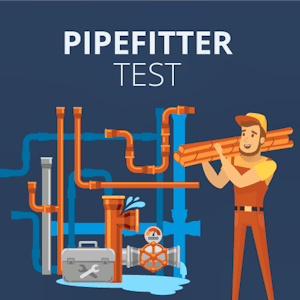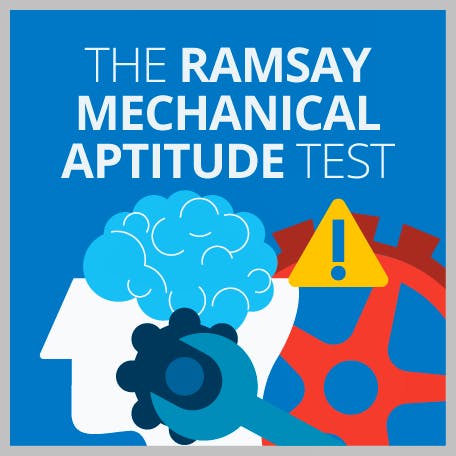Pipefitter Test: Guide & Tips 2025
Updated November 18, 2023

- What Is the Pipefitter Assessment Test?
- How Does the Pipefitter Exam Work?
- What Is the Passing Score for the Pipefitter Test?
- Pipefitter Practice Test Example Questions
empty
empty
empty
empty
empty
empty
empty
- Prepare for the Pipefitter Assessment Test
- Other Considerations for the Pipefitter Assessment Test
empty
empty
empty
- Frequently Asked Questions
- Final Thoughts

Mastering the Pipefitter Test is crucial for those entering the field.
This guide provides valuable insights, a pipefitter sample test and strategies to conquer the examination.
Discover expert tips to excel in your pipefitting career by navigating the challenges of this important assessment.
What Is the Pipefitter Assessment Test?
The Pipefitter test is an important evaluation tool for individuals aspiring to secure roles as pipefitters in the construction and industrial sectors.
Qualifications and certifications necessary for such positions can vary by state. This makes the pipefitter assessment test a valuable method of demonstrating skills and knowledge.
The National Center for Construction Education and Research (NCCER) administers the most popular pipefitter assessment test, designed to assess the potential skills of candidates.
It covers the principles related to the installation and maintenance of both high and low-pressure pipe systems.
In addition, it focuses on how these are used across various sectors, including manufacturing, electricity generation and climate control systems in buildings.
How Does the Pipefitter Exam Work?
The pipefitter test consists of four levels. These align with the rigorous standards set by the U.S. Department of Labor.
The four levels cover a diverse range of subjects.
These include:
- Piping systems and testing
- Excavations
- Pipefitting mathematics
- Identification and installation of valves
- Pipefitting hand tools
- Rigging practices
The pipefitter assessment is a closed-book examination. There are 125 pipefitter test questions in the NCCER pipefitter certification test.
It is offered in both English and Spanish languages, accommodating a wider range of candidates.
Test-takers are allotted a three-hour time limit to complete the assessment.
The cost to take the test is $70.00 and during the assessment, candidates are permitted to use a basic function calculator to aid in their calculations and problem-solving.
Candidates can also refer to The Pipefitters Blue Book by W.V. Graves as a reference source.
No other study materials are allowed but a pencil and paper are provided if needed.
What Is the Passing Score for the Pipefitter Test?
To successfully pass the NCCER Pipefitter test, candidates are required to achieve a minimum score of 75.
This passing score reflects the proficiency and competence necessary to secure roles as pipefitters in the construction and industrial sectors.
Pipefitter Practice Test Example Questions
Test yourself with this pipefitter practice test with answers.
Question 1
Which of the following materials is commonly used for residential water supply pipes?
a) PVC
b) Copper
c) Steel
d) Aluminum
What is the purpose of a flange in a pipe system?
a) To increase the flow rate
b) To connect pipes of different materials
c) To provide a smooth interior surface
d) To allow for easy disassembly and maintenance
When calculating the circumference of a pipe, which formula should be used?
a) Circumference = π × diameter
b) Circumference = 2 × radius
c) Circumference = π × radius
d) Circumference = 2 × diameter
Which of the following is NOT a type of pipe joint commonly used in pipefitting?
a) Socket weld
b) Butt weld
c) Threaded
d) Soldered
Where should a cooling tower typically be installed in an industrial facility?
a) Adjacent to the main entrance for easy access
b) Close to the employee break area for convenience
c) Near the source of heat or machinery requiring cooling
d) In a remote location away from the facility

What is the primary cause of water hammering in a steam boiler system?
a) Insufficient water supply to the boiler
b) Air trapped in the steam pipes
c) Excessive steam pressure in the system
d) Low fuel supply to the boiler
If a circular template is divided into 12 equal spaces, how many degrees are there in each space?
a) 15 degrees
b) 20 degrees
c) 30 degrees
d) 45 degrees
If you need to prepare for a number of different employment tests and want to outsmart the competition, choose a Premium Membership from JobTestPrep.
You will get access to three PrepPacks of your choice, from a database that covers all the major test providers and employers and tailored profession packs.
Prepare for the Pipefitter Assessment Test
Preparation for the Pipefitter Assessment Test is essential to achieve success.
Here are several steps to help candidates get ready for the examination.
Step 1. Practice Assessments
Taking practice assessments for pipefitter test prep is crucial. These practice tests help candidates become familiar with the types of questions and the format of the actual test.
It also allows them to identify areas where they may need additional study.
Step 2. Time Management
Candidates should prepare for effective time management during the test. With a three-hour time limit, it's essential to allocate time wisely for each section or question.
This prevents spending too much time on a single question and potentially running out of time for others.
Step 3. Strategic Question Approach
Encourage candidates to adopt a strategic approach to questions.
If they encounter a challenging question, it's beneficial to skip it temporarily and return to it later. This ensures they make the most of their time and don't get stuck on one difficult item.
Step 4. Review Answers
After answering each question, candidates should briefly review their pipefitter test and answers.
This quick check helps catch any errors or omissions, ensuring that questions are answered correctly.
Step 5. Effective Study Time
Allocate enough time for study and review in the lead-up to the test.
This includes reviewing essential concepts, practicing problem-solving and reinforcing knowledge in areas where improvement is needed.
Step 6. Study Materials
Use study materials such as textbooks, online resources and study guides specific to pipefitting.
These materials can provide valuable information and practice pipe fitter exam questions to reinforce learning.
Step 7. Group Study
Consider joining or forming study groups with others preparing for the same test.
Group study sessions can provide diverse perspectives, explanations and support in areas where candidates may struggle.
Step 8. Seek Guidance
If candidates encounter challenging concepts or questions during their preparation, they should not hesitate to seek guidance from experienced pipefitters, instructors or mentors.
Step 9. Stay Calm and Confident
On the day of the test, candidates should remain calm and confident. Nervousness can affect performance, so it's important to maintain a positive mindset.
Other Considerations for the Pipefitter Assessment Test
In addition to the core knowledge and skills required for the Pipefitter Assessment Test, candidates should also consider other crucial aspects of the profession to excel in their roles.
These considerations encompass the proper use of tools and equipment, safety measures and the integration of technology.
Tools and Equipment
Candidates must have a comprehensive understanding of the tools and equipment commonly used in pipefitting.
Knowing how to operate and maintain these tools correctly is vital to completing tasks efficiently and safely.
Examples of tools include saws, levels, power tools, welding torches, blow torches and pressure gauges.
Businesses prioritize this knowledge to prevent equipment damage and ensure a smooth workflow.
Safety Gear and Clothing
Safety should be paramount for pipefitters. Understanding the importance of proper clothing and protective gear is essential for personal safety and the well-being of others on the job site.
This includes wearing helmets, face shields, goggles, steel-toed boots, high-visibility vests and other safety equipment relevant to the specific job environment. Employers value candidates who prioritize safety practices.
Technological Proficiency
Modern pipefitting is evolving with technology, making certain tasks more efficient.
Pipefitters should be aware of and capable of using the latest technology and tools, such as mobile apps and computers, which can aid in tasks like blueprint analysis, measurements and documentation.
Adaptability to technology is becoming increasingly important in the industry and candidates who embrace it can enhance their productivity and job prospects.
By considering these additional factors beyond the core knowledge areas covered in the Pipefitter Assessment Test, candidates can demonstrate their readiness for the demands of the profession and increase their value to employers.
Being proficient in equipment usage, safety practices and technology integration contributes to a successful and well-rounded career in pipefitting.
Frequently Asked Questions
The difficulty of the Pipefitter test varies based on your level of experience and preparation.
It can be challenging for those with limited knowledge but manageable for those well-prepared.
Success depends on effective studying, practice and time management during the test.
To pass the Pipefitter test, use a pipe fitter test study guide, take practice tests, manage your time well during the exam, review your answers and maintain a calm and focused mindset.
Effective preparation with a pipefitter test study guide is key to passing.
You can prepare for the Pipefitter test through a pipefitters exam study guide, textbooks, online resources, practice tests and study groups.
You can also seek guidance from experienced pipefitters or instructors.
The number of questions on the Pipefitter test can vary by test version and level.
Contact the testing organization, such as (NCCER), for precise details on the number of questions in the specific test you'll take.
Yes, most organizations allow candidates to retake the Pipefitter test if they do not pass on their first attempt.
Check with the testing organization for their retake policies.
Yes, many Pipefitter tests are available in an online format. It's advisable to confirm with the testing organization whether online testing is an option for your specific test.
A good score on the Pipefitter test typically meets or exceeds the passing score, which is often set at a minimum of 75.
However, higher scores may be required for more competitive positions or advanced levels of certification.
Final Thoughts
The Pipefitters Test is a crucial step for individuals aspiring to pursue a career as a pipefitter.
With a passing score of 75, it's evident that a strong level of knowledge and preparation is necessary to succeed.
Properly preparing for the test through studying, practice assessments and time management is essential to meet this threshold.
Achieving a good score not only validates your skills but also enhances your prospects in the field of pipefitting.
Remember that continuous learning and staying updated with industry standards will contribute to a successful career as a pipefitter.













